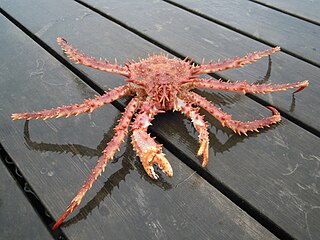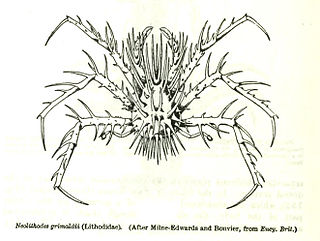
King crabs are a taxon of decapod crustaceans that are chiefly found in cold seas. Because of their large size and the taste of their meat, many species are widely caught and sold as food with the most common being the red king crab.

Squat lobsters are dorsoventrally flattened crustaceans with long tails held curled beneath the cephalothorax. They are found in the two superfamilies Galatheoidea and Chirostyloidea, which form part of the decapod infraorder Anomura, alongside groups including the hermit crabs and mole crabs. They are distributed worldwide in the oceans, and occur from near the surface to deep sea hydrothermal vents, with one species occupying caves above sea level. More than 900 species have been described, in around 60 genera. Some species form dense aggregations, either on the sea floor or in the water column, and a small number are commercially fished.

Anomura is a group of decapod crustaceans, including hermit crabs and others. Although the names of many anomurans include the word crab, all true crabs are in the sister group to the Anomura, the Brachyura.

Glyptolithodes cristatipes, also known as the Peruvian centolla, is a species of king crab, and the only species in the genus Glyptolithodes. The species was briefly placed in the related genus Rhinolithodes after its initial description, but was soon moved to its own genus.

Lithodes maja, the Norway king crab or northern stone crab, is a species of king crab which occurs in colder North Atlantic waters off Europe and North America. It is found along the entire coast of Norway, including Svalbard, ranging south into the North Sea and Kattegat, the northern half of the British Isles, and around the Faroe Islands, Iceland, and off south-eastern Greenland. In the West Atlantic, it ranges from the Davis Strait between Greenland and Canada south to The Carolinas in the United States.
Lithodes galapagensis is a species of king crab described in 2009 that lives around the Galapagos Islands, where known from depths of 648 and 740 m. The two specimens upon which it was described had a carapace length of 11.4 and 8.4 cm, and the species quite resembles L. wiracocha from Peru.

Lithodes is a genus of king crabs. Today there are about 30 recognized species, but others formerly included in this genus have been moved to Neolithodes and Paralomis. They are found in oceans around the world, ranging from shallow to deep waters, but mostly at depths of 100–1,000 m (300–3,300 ft). They are restricted to relatively cold waters, meaning that they only occur at high depths at low latitudes, but some species also shallower at high latitudes. They are medium to large crabs, and some species are or were targeted by fisheries.

Neolithodes is a genus of king crabs, in the family Lithodidae. They are found in all major oceans, both in high and low latitudes. Although there are records from water as shallow as 124 m (407 ft) in cold regions, most records are much deeper, typically 700–2,000 m (2,300–6,600 ft), with the deepest confirmed at 5,238 m (17,185 ft). They are fairly large to large crabs that typically are reddish in color and spiny, although the size of these spines varies depending on species.

Neolithodes grimaldii, the porcupine crab, is a species of king crab in the family Lithodidae. This large red crab is found in cold deep waters in the North Atlantic and often caught as a bycatch in fisheries for Greenland turbot. As suggested by its common name, the carapace and legs are covered in long spines.

Neolithodes agassizii is a species of king crab native to the Western Atlantic. They live at depths of 200–1,900 metres (660–6,230 ft), and have been found as far south as Rio de Janeiro, as far north as latitude 36°, and near the Equator. It has been found in the southwestern Caribbean Sea as well as the Gulf of Mexico.
Cryptolithodes expansus is a species of king crab native to the Korean coast and Japan. They live in the sublittoral zone to a depth of approximately 50–60 metres (160–200 ft). Adults measure approximately 50 mm (2.0 in) wide and 80 mm (3.1 in) long and have a rostrum of about 10 mm (0.39 in).
Neolithodes asperrimus is a species of king crab native to the coast of Africa. It has been found in South Africa and Mauritania at depths of 997–1,862 metres (3,271–6,109 ft), and Neolithodes aff. asperrimus has been found in Madagascar, Réunion, and the South Region of Brazil.
Neolithodes capensis is a species of king crab which is found in the Southern Ocean and the western Indian Ocean. It has been found to a depth of 660–3,200 metres (2,170–10,500 ft).

Neolithodes diomedeae is a species of king crab which is found in the eastern Pacific Ocean, the southwestern Atlantic Ocean, and the Bellingshausen and Scotia Seas in the Southern Ocean. They occur from 200 to 2,454 m.

Lithodes aoteoroa is a New Zealand species of king crab in the family, Lithodidae, and was first described in 2010 by Shane T. Ahyong. It had formerly been confused with L. longispina and L. murrayi, but neither of those species are found in New Zealand.
Lithodes longispina is a species of king crab. It has been found in Japan and Taiwan. Before 2010, its reach was thought to be much greater than presently understood, such as Australia, New Zealand, and Guam. It has also allegedly been sighted in the Northwestern Hawaiian Islands.
Lithodes megacantha is a species of king crab in the genus Lithodes. They are bright red and have been found in French Polynesia at depths of around 1,000 m (3,300 ft).
Lithodes formosae is a species of king crab. It is presently known to be found in Taiwan from depths of 500–600 m (1,600–2,000 ft).
Lithodes macquariae is a species of king crab located off Macquarie Island, the Auckland Islands, and Peter I Island. It has been found at depths of 16–1,140 m (52–3,740 ft)
Lithodes confundens is a species of king crab.












